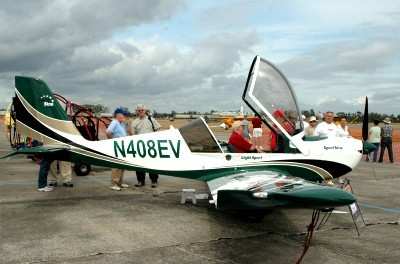Could GA Return The Favor?
Commentary And Analysis By Gene Yarbrough
Wish I were, wish I might, the FAA is nowhere in sight. As
congress has failed to pass legislation to continue funding the
FAA, Airventure finds itself previously, unimaginably short of FAA
representation. This strange turn of events has created a buzz of
jokes and musings of what would happen if the FAA truly weren't in
general aviation on the grounds of Wittman Field. Many propose a
utopia of foregone freedoms while others are fearful airplanes will
spontaneously fall out of the skies because BIG BROTHER is not
strong-arming regulatory enforcement.

All kidding aside, the fact that the FAA has been temporarily
crippled begs the question, “Could general aviation survive
without FAA oversight as we currently know it?”
Looking around the landscape for a comparable surrogate finds
the Light Sport Aircraft category doing quite well left to its own
devices. Certainly there is the potential for mishandling within
this self regulated area of GA. But by all currently measurable
indices, LSA is policing itself in a respectable manner with some
sense of integrity. There have been no media reports of gross abuse
as yet, and there seems to be enough threat within the legal system
to promote continued maintenance of high quality standards.
This is not to suggest that the FAA be removed from GA entirely,
but the notion that GA, or at least certain parts such as personal
aviation (being more clearly defined as that part of aviation that
is intended primarily for recreational or personal use not intended
for commercial operations) could regulate itself with less direct
Federal oversight may not be novel -- but does not enjoy any
organized consciousness. Perhaps this brief respite from FAA
presence will give the GA community the ability to demonstrate that
we are capable of manufacturing and operating aircraft safely on
our own recognizance.

The FAA has a duty to the public at large to ensure that all
aspects of aviation are safe and reliable. This is a noble charge
and the FAA has done an admirable job at making the USA a leader in
commercial aviation safety. Coupled with the NTSB, the FAA has
brought proper and necessary regulatory mandates and continues to
require airlines to maintain the highest standards which have
greatly improved safety for the traveling public and rightly so.
However; the FAA has not differentiated, well, what are appropriate
standards for GA aircraft. While it is wrong to suggest that GA
should not have high safety standards, a one size fits all approach
is crippling the GA manufacturers’ ability to produce an
affordable product.
In the current environment an aircraft manufacturer is required
to test airframes to meet certain requirements that may, or in many
cases do not, represent real world conditions for their product. A
simple tube and fabric aircraft does not operate in the same
environment as a pressurized cabin class executive aircraft, but
the regulations do not differentiate between the two
sufficiently. ASTM regulations governing LSA aircraft are
written in such a way as to allow the manufacturers to apply only
those regulations pertaining to their product, but more importantly
they give the manufacturers the latitude to show compliance via
self testing, or engineering analysis, or even flight testing. Not
having to go through the FAA, or DER/DAR, to get approval for every
design change greatly reduces the cost of bringing a product to
market. Some estimates to develop and certify a new 14CFR Part 23
aircraft, do all the required testing and conformance, and get
approval from FAA are exceeding millions of dollars. This is a
huge and unsustainable burden for GA airplane companies.

Ever wonder why airplanes cost so much compared to cars and yet
are eons behind in technology? Look at the cost of certifying a new
design juxtaposed to the numbers of units that will be built and
the math becomes clear. Production numbers are a function of the
marketplace but millions more could afford a $50,000 airplane than
a $250,000 airplane. If the GA producers could put a million units
into the field per year new technologies in manufacturing would
have to be employed as a function of necessity to meet demand and
economies of scale would cut per unit costs by orders of magnitude.
Rather aircraft and their sundry components are hand built which
limits manufacturing technologies and certification hassles quench
innovation. Still the costs of meeting regulations impose a huge
cost per unit, product liability insurance usually takes about half
of the retail price and the manufacturer is left to eke out what
marginal profit they can. Redirecting the regulatory burden to the
manufacturers and letting the free market and legal hounds hold
everyone accountable seems to work so far in LSA.
Shifting the regulatory paradigm to meet the LSA model is
certainly plausible, but would take a huge and organized effort on
the part of pilots, manufacturers, and consumers of GA as a whole.
Perhaps this brief absence of FAA presence has sparked a glimmer of
what could be. The golden age of personal general aviation has
waned according to most, but maybe, just maybe if enough people
were to come together towards a singular focused goal we could make
a difference in the right direction. Aero-News Network is beginning
this initiative……stay tuned.

Editor's Note: DOT Secretary Ray LaHood and FAA
Adminitrator Randy Babbitt are scheduled to make their annual visit
to AirVenture Thursday ... despite the furloughs and lack of a
short-term or long-term funding mechanism for the FAA.
 Unfortunate... ANN/SportPlane Resource Guide Adds To Cautionary Advisories
Unfortunate... ANN/SportPlane Resource Guide Adds To Cautionary Advisories ANN FAQ: Turn On Post Notifications
ANN FAQ: Turn On Post Notifications ANN's Daily Aero-Term (04.29.24): Visual Approach Slope Indicator (VASI)
ANN's Daily Aero-Term (04.29.24): Visual Approach Slope Indicator (VASI) ANN's Daily Aero-Term (04.28.24): Airport Marking Aids
ANN's Daily Aero-Term (04.28.24): Airport Marking Aids ANN's Daily Aero-Linx (04.28.24)
ANN's Daily Aero-Linx (04.28.24)






